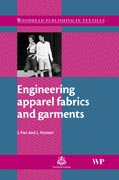
As consumer demands for specific attributes in their textiles increase and global competition intensifies, it is important that the industry finds ways of engineering certain performance requirements into textiles and apparel. This book reviews how fabrics and garments can be engineered to meet technical performance and other characteristics required for the specific end-use. Chapters begin with fabric and garment handle and making - up performance, followed by wear appearance issues, such as wrinkling, pilling and bagging. Further chapters include fabric and garment drape, durability related issues, as well as physiological and psychological comfort. Key topics of fire retardancy, waterproofing, breathability and ultraviolet protection are also discussed. Written bytwo highly distinguished authors, this is an invaluable book for a wide rangeof readers in the textile and apparel industries, ranging from textile and garment manufacturers, designers, researchers, developers to buyers. INDICE: Handle and making-up performance of fabrics and garments L Hunter and E L Hunter - Introduction - Fabric Objective Measurement (FOM) of fabric handle and making-up performance - Other methods - Effect of fibre properties -Effect of yarn properties - Effect of fabric properties - Effect of dyeing and finishing (chemical and mechanical) treatments - General - Sources of further information and advice - References Wrinkling of fabrics and garments L Hunter - Introduction - The measurement of wrinkle and crease recovery - Surface smoothness after repeated laundering - Factors affecting fabric wrinkling and recovery - Factors affecting wrinkling during wear - Effect of fibre properties- Effect of yarn and fabric parameters - Effects of fibre, yarn and fabric processing parameters - Concluding remarks - Sources of further information and advice - References Pilling of fabrics and garments L Hunter - Introduction - Effects of fibre composition and properties - Effects of yarn structure and properties - Effect of fabric structure and properties - Effects of fibre, yarn and fabric processing parameters - Sources of further information and advice -Concluding remarks - References Bagging of fabrics and garments L Hunter - Introduction - The measurement of bagging - Effect of fibre properties - Effect of yarn properties - Effect of fabric properties - Effect of garment construction - Effect of finishing - Fabric bagging prediction and modelling - Sources of further information and advice - Concluding remarks - References Fabric andgarment drape L Hunter, J Fan and D Chau - Introduction - Drape measurement -Engineering fabric drape - Empirical prediction of drape - Modelling fabric and garment drape - Drape models in CAD and internet systems - Sources of further information and advice - Concluding remarks - References Appearance issues in garment processing J Fan, L Lau and L Hunter - Introduction - Seam appearance - Appearance issues in fusing - Appearance issues in garment dyeing - Appearance issues in pressing - Storage and packaging - Concluding remarks - References Durability of fabrics and garments L Hunter - Introduction - Abrasion resistance - Fabric and garment strength - Effect of dyeing and finishing on fabric strength - Modelling and predicting fabric strength - Sources of further information and advice - Conclusions - References Physiological comfort of fabrics and garments J Fan - Introduction - Different aspects of clothing physiological comfort - Tactile comfort - Assessment of tactile comfort - Thermophysiological comfort - Liquid water transport properties of fabrics and clothing - Garment fit and ease of body movement - Pressure comfort - Concluding remarks -References Psychological comfort of fabrics and garments J Fan - Introduction- Assessment of psychological comfort - Factors which affect psychological comfort - Effect of colour and surface texture - Effect of garment design - Effect of garment sizing and fit - Fashion and prejudice - Concluding remarks - References Flammability of fabrics and garments J Fan and L Lau - Introduction -Burning mechanisms - Index for burning behaviour of textiles - Effects of fibre composition, structure and properties - Effects of yarn structure and properties - Effect of fabric structure and properties - Effect of fibre, yarn and fabric processing parameters - Effect of garment design - Test methods and standards for textiles and apparels - Concluding remarks - References Waterproofing and breathability of fabrics and garments L Hunter and J Fan - Introduction- Definitions - Measurement of waterproofing and breathability - Engineering fabric and garment breathability - Fabric finishes - Construction of showerproof garments - Comparative fabric and garment properties - Sources of further information and advice - Concluding remarks - References Ultraviolet protectionof fabrics and garments L Hunter - Introduction - Measurement of UV protection - Effect of fibre properties - Effect of yarn properties - Effect of fabric structure and properties - Effects of dyeing, finishing and other chemical treatments - Sources of further information and advice - Concluding remarks - References Laundry performance of fabrics and garments L Lau and J Fan - Introduction - Laundering - Care labels - Effects of fibre composition, structure and properties - Effects of sewing thread linear density - Effects of fabric structure and properties - Effects of colouration and finishing - Effects of garment design - Test methods and standards related to laundering and care labelling- Concluding remarks - References Application of artificial intelligence in fabric and garment engineering J Fan - Introduction - Expert systems - Artificial Neural Networks (ANN) - Concluding remarks - References
- ISBN: 978-1-84569-134-9
- Editorial: Woodhead
- Encuadernacion: Cartoné
- Páginas: 416
- Fecha Publicación: 01/05/2009
- Nº Volúmenes: 1
- Idioma: Inglés
